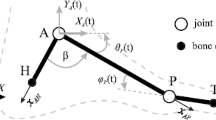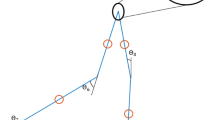Abstract
Foot–ground contact models play an important role in the accuracy of predictive human gait simulations, and there is a need for a computationally-efficient dynamic contact model for predictive and evaluative studies. In this research, we generated symbolic dynamic equations for a 2D torque-driven 11-DOF human model with a 3D ellipsoidal volumetric foot–ground contact model. The main goal was to increase the prediction accuracy and decrease the computation time for human gait analyses compared to the previous studies that used numerical formulations and point foot–ground contact models.
A data-tracking optimization was developed to identify the contact parameters of the human gait model using two optimization approaches: trajectory optimization and optimal control. The first approach is developed with a global search algorithm based on inverse dynamics. In this algorithm, a local optimizer is repeatedly run from multiple potential start points to select the best start point while satisfying the constraints and reaching the lowest cost function value. The second approach is developed using direct collocation based on implicit dynamics. In this method, the optimization problem is solved using a variable-order adaptive orthogonal collocation method along with sparse nonlinear programming.
Optimal control was superior to trajectory optimization for identifying a large number of parameters; the simulated torques and ground reaction forces from the optimal control correlated better with the experimental data. For the optimal control, the root-mean-square errors of the resultant torques, tangential and normal ground reaction forces were 0.48 (N.m), 14.07 (N), and 26.44 (N), respectively. However, for the trajectory optimization, these errors were 15.19 (N.m), 36.51 (N), and 234.57 (N). Thus, the optimized contact model from the optimal control, which was developed symbolically and based on volumetric contact equations, is a suitable foot–ground contact model for predictive human gait simulations. Additionally, we demonstrated that optimal control could be used to predict the motion and torque for the metatarsal joints, which are not easily measurable in practice.













Similar content being viewed by others
References
Anderson, F.C., Pandy, M.G.: Individual muscle contributions to support in normal walking. Gait Posture 17(2), 159–169 (2003). https://doi.org/10.1016/S0966-6362(02)00073-5
van den Bogert, A.J., Blana, D., Heinrich, D.: Implicit methods for efficient musculoskeletal simulation and optimal control. Proc. IUTAM 2, 297–316 (2011). https://doi.org/10.1016/J.PIUTAM.2011.04.027
Bovi, G., Rabuffetti, M., Mazzoleni, P., Ferrarin, M.: A multiple-task gait analysis approach: kinematic, kinetic and EMG reference data for healthy young and adult subjects. Gait Posture 33(1), 6–13 (2011). https://doi.org/10.1016/j.gaitpost.2010.08.009
Brown, P.: Contact Modelling for Forward Dynamics of Human Motion. Masters thesis, University of Waterloo (2017)
Brown, P., McPhee, J.: A 3D ellipsoidal volumetric foot–ground contact model for forward dynamics. Multibody Syst. Dyn. 42(4), 447–467 (2018). https://doi.org/10.1007/s11044-017-9605-4
Erdemir, A., Piazza, S.J.: Changes in foot loading following plantar fasciotomy: a computer modeling study. J. Biomech. Eng. 126(2), 237 (2004). https://doi.org/10.1115/1.1691447
Ezati, M., Ghannadi, B., McPhee, J.: A review of simulation methods for human movement dynamics with emphasis on gait. Multibody Syst. Dyn. 47, 265–292 (2019). https://doi.org/10.1007/s11044-019-09685-1
Ezati, M., Khadiv, M., Moosavian, S.: An investigation on the usefulness of employing a two-segment foot for traversing stairs. Int. J. Humanoid Robot. 14(4), 1750027 (2017). https://doi.org/10.1142/S021984361750027X
Fregly, B.J., Bei, Y., Sylvester, M.E.: Experimental evaluation of an elastic foundation model to predict contact pressures in knee replacements. J. Biomech. 36(11), 1659–1668 (2003). https://doi.org/10.1016/S0021-9290(03)00176-3
Geyer, H., Herr, H.: A Muscle-reflex model that encodes principles of legged mechanics produces human walking dynamics and muscle activities. IEEE Trans. Neural Syst. Rehabil. Eng. 18(3), 263–273 (2010). https://doi.org/10.1109/TNSRE.2010.2047592
Ghannadi, B., Mehrabi, N., Sharif Razavian, R., McPhee, J.: Nonlinear model predictive control of an upper extremity rehabilitation robot using a two-dimensional human-robot interaction model. In: IEEE/RSJ International Conference on Intelligent Robots and Systems (IROS), pp. 502–507. IEEE, Vancouver (2017). https://doi.org/10.1109/IROS.2017.8202200
Gilardi, G., Sharf, I.: Literature survey of contact dynamics modelling. Mech. Mach. Theory 37(10), 1213–1239 (2002). https://doi.org/10.1016/S0094-114X(02)00045-9
Gonthier, Y.: Contact Dynamics Modelling for Robotic Task Simulation. PhD thesis, University of Waterloo (2007)
Gonthier, Y., McPhee, J., Lange, C., Piedbœuf, J.C.: A contact modeling method based on volumetric properties. In: Volume 6: 5th International Conference on Multibody Systems, Nonlinear Dynamics, and Control, Parts A, B, and C, vol. 2005, pp. 477–486. ASME, Long Beach (2005). https://doi.org/10.1115/DETC2005-84610
Grönqvist, R., Abeysekera, J., Gard, G., Hsiang, S.M., Leamon, T.B., Newman, D.J., Gielo-Perczak, K., Lockhart, T.E., Pai, C.Y.: Human-centred approaches in slipperiness measurement. In: Ergonomics, vol. 44, pp. 1167–1199. Taylor & Francis, London (2001). https://doi.org/10.1080/00140130110085556
Hunt, K.H., Crossley, F.R.E.: Coefficient of restitution interpreted as damping in vibroimpact. J. Appl. Mech. 42(2), 440 (1975). https://doi.org/10.1115/1.3423596
Koenraadt, K.L., Stolwijk, N.M., van den Wildenberg, D., Duysens, J., Keijsers, N.L.: Effect of a metatarsal pad on the fore-foot during gait. J. Am. Podiatr. Med. Assoc. 102(1), 18–24 (2012). https://doi.org/10.7547/1020018
Leardini, A., Benedetti, M.G., Berti, L., Bettinelli, D., Nativo, R., Giannini, S.: Rear-foot, mid-foot and fore-foot motion during the stance phase of gait. Gait Posture 25(3), 453–462 (2007). https://doi.org/10.1016/j.gaitpost.2006.05.017
Lim, Y.P., Lin, Y.C., Pandy, M.G.: Effects of step length and step frequency on lower-limb muscle function in human gait. J. Biomech. 57, 1–7 (2017). https://doi.org/10.1016/j.jbiomech.2017.03.004
Lin, Y.C., Haftka, R.T., Queipo, N.V., Fregly, B.J.: Surrogate articular contact models for computationally efficient multibody dynamic simulations. Med. Eng. Phys. 32(6), 584–594 (2010). https://doi.org/10.1016/j.medengphy.2010.02.008
Lin, Y.C., Kim, H.J., Pandy, M.G.: A computationally efficient method for assessing muscle function during human locomotion. Int. J. Numer. Methods Biomed. Eng. 27(3), 436–449 (2011). https://doi.org/10.1002/cnm.1396
Lin, Y.C., Pandy, M.G.: Three-dimensional data-tracking dynamic optimization simulations of human locomotion generated by direct collocation. J. Biomech. 59, 1–8 (2017). https://doi.org/10.1016/j.jbiomech.2017.04.038
Lin, Y.C., Walter, J.P., Pandy, M.G.: Predictive simulations of neuromuscular coordination and joint-contact loading in human gait. Ann. Biomed. Eng. 46(8), 1216–1227 (2018). https://doi.org/10.1007/s10439-018-2026-6
Lopes, D.S., Neptune, R.R., Ambrósio, J.A., Silva, M.T.: A superellipsoid-plane model for simulating foot–ground contact during human gait. Comput. Methods Biomech. Biomed. Eng. 19(9), 954–963 (2016). https://doi.org/10.1080/10255842.2015.1081181
Mclaughlin, T., Zourntos, T.: Using Fourier analysis to generate believable gait patterns for virtual quadrupeds. Masters thesis, Texas A&M University (2013)
McPhee, J., Wells, C.: Automated symbolic analysis of mechanical system dynamics. MapleTech 3, 48–56 (1996)
Meyer, A.J., Eskinazi, I., Jackson, J.N., Rao, A.V., Patten, C., Fregly, B.J.: Muscle synergies facilitate computational prediction of subject-specific walking motions. Front. Bioeng. Biotechnol. 4, 77 (2016). https://doi.org/10.3389/fbioe.2016.00077
Millard, M., McPhee, J., Kubica, E.: Multi-step forward dynamic gait simulation. In: Bottasso, C.L. (ed.) Multibody Dynamics, pp. 25–43. Springer, Dordrecht (2009). https://doi.org/10.1007/978-1-4020-8829-2_2
Miller, R.H.: A comparison of muscle energy models for simulating human walking in three dimensions. J. Biomech. 47(6), 1373–1381 (2014). https://doi.org/10.1016/j.jbiomech.2014.01.049
Mouzo, F., Lugris, U., Pamies Vila, R., Font Llagunes, J.M., Cuadrado Aranda, J.: Underactuated approach for the control-based forward dynamic analysis of acquired gait motions. In: Proceedings of the ECCOMAS Thematic Conference on Multibody Dynamics, pp. 1092–1100 (2015)
Neptune, R.R., Wright, I.C., van den Bogert, A.J.: A method for numerical simulation of single limb ground contact events: application to heel–toe running. Comput. Methods Biomech. Biomed. Eng. 3(4), 321–334 (2000). https://doi.org/10.1080/10255840008915275
Patterson, M.A., Rao, A.V.: GPOPS-II. ACM Trans. Math. Softw. 41(1), 1–37 (2014). https://doi.org/10.1145/2558904
Peasgood, M., Kubica, E., McPhee, J.: Stabilization of a dynamic walking gait simulation. J. Comput. Nonlinear Dyn. 2(1), 65 (2007). https://doi.org/10.1115/1.2389230
Porsa, S., Lin, Y.C., Pandy, M.G.: Direct methods for predicting movement biomechanics based upon optimal control theory with implementation in OpenSim. Ann. Biomed. Eng. 44(8), 2542–2557 (2016). https://doi.org/10.1007/s10439-015-1538-6
Rao, A.V.: A survey of numerical methods for optimal control. Adv. Astronaut. Sci. 135(1), 497–528 (2009). https://doi.org/10.1515/jnum-2014-0003
Sandhu, S.S., McPhee, J.: A two-dimensional nonlinear volumetric foot contact model. In: Volume 2: Biomedical and Biotechnology Engineering, pp. 703–710. ASME, Vancouver (2010). https://doi.org/10.1115/IMECE2010-39464
Sharif Shourijeh, M.: Optimal Control and Multibody Dynamic Modelling of Human Musculoskeletal Systems (2013)
Sharif Shourijeh, M., McPhee, J.: Forward dynamic optimization of human gait simulations: a global parameterization approach. J. Comput. Nonlinear Dyn. 9(3), 031,018 (2014). https://doi.org/10.1115/1.4026266
Shourijeh, M.S., McPhee, J.: Foot–ground contact modeling within human gait simulations: from Kelvin–Voigt to hyper-volumetric models. Multibody Syst. Dyn. 35(4), 393–407 (2015). https://doi.org/10.1007/s11044-015-9467-6
Silva, M., Freitas, B., Andrade, R., Carvalho, Ó., Renjewski, D., Flores, P., Espregueira-Mendes, J.: Current perspectives on the biomechanical modelling of the human lower limb: a systematic review. Arch. Comput. Methods Eng. (2020). https://doi.org/10.1007/s11831-019-09393-1
Smith, C.R., Vignos, M.F., Lenhart, R.L., Kaiser, J., Thelen, D.G.: The influence of component alignment and ligament properties on tibiofemoral contact forces in total knee replacement. J. Biomech. Eng. 138(2), 021,017 (2016). https://doi.org/10.1115/1.4032464
Sun, J., Voglewede, P.A.: Dynamic simulation of human gait using a combination of model predictive and PID control. In: Volume 6: 10th International Conference on Multibody Systems, Nonlinear Dynamics, and Control, p. V006T10A008. ASME, Buffalo (2014). https://doi.org/10.1115/DETC2014-35582
Sun, J., Wu, S., Voglewede, P.A.: Dynamic simulation of human gait model with predictive capability. J. Biomech. Eng. 140(3), 031,008 (2018). https://doi.org/10.1115/1.4038739
Ugray, Z., Lasdon, L., Plummer, J., Glover, F., Kelly, J., Martí, R.: Scatter search and local NLP solvers: a multistart framework for global optimization. INFORMS J. Comput. 19(3), 328–340 (2007). https://doi.org/10.1287/ijoc.1060.0175
Umberger, B.R.: Effects of suppressing arm swing on kinematics, kinetics, and energetics of human walking. J. Biomech. 41(11), 2575–2580 (2008). https://doi.org/10.1016/j.jbiomech.2008.05.024
Winter, D.A.: Biomechanics and Motor Control of Human Movement. Wiley, New York (2009)
Zmitrowicz, A.: Contact stresses: a short survey of models and methods of computations. Arch. Appl. Mech. 80(12), 1407–1428 (2010). https://doi.org/10.1007/s00419-009-0390-2
Acknowledgements
This research was funded by the Natural Sciences and Engineering Research Council of Canada and the Canada Research Chairs program. Special thanks to Marco Rabuffetti and Maurizio Ferrarin from Polo Tecnologico, IRCCS S. Maria Nascente, Fondazione Don C. Gnocchi, Italy, for providing us with their gait experimental data.
Author information
Authors and Affiliations
Corresponding author
Additional information
Publisher’s Note
Springer Nature remains neutral with regard to jurisdictional claims in published maps and institutional affiliations.
Rights and permissions
About this article
Cite this article
Ezati, M., Brown, P., Ghannadi, B. et al. Comparison of direct collocation optimal control to trajectory optimization for parameter identification of an ellipsoidal foot–ground contact model. Multibody Syst Dyn 49, 71–93 (2020). https://doi.org/10.1007/s11044-020-09731-3
Received:
Accepted:
Published:
Issue Date:
DOI: https://doi.org/10.1007/s11044-020-09731-3




